Thoughts and observations on what make cities great places to live
Don't wanna be here? Send us removal request.
Text
Urban Renewal: How Simple Acts and Third Spaces can Reconnect Our Communities

As we navigate this post-pandemic world, I've been pondering the idea of connection, particularly in our urban spaces. It's why I launched the Urban Renewal series to focus on how we can improve social connections in our communities. For the first installment of the series, I had the pleasure of chatting with fellow Vancouverite, Peg Fong, a journalist, author, and educator who launched a podcast and book during the pandemic titled, Alone Together, exploring the topic of loneliness in cities.
In our conversation, Peg shared her insights on how we can rebuild a sense of community.
The Simple Act of Walking
During the pandemic when we were mostly confined to our homes, the ability to stroll through the neighborhood and see other people was often our main source of face-to-face interaction.
"I live in Yaletown, a very walkable area of Vancouver, which was something I took for granted," Peg shared. “But during the pandemic it became so important to have these public spaces where we could walk and see other people around, even if we couldn't be together.”
Public spaces like parks and sidewalks became lifelines for connecting with others, reminding us that we weren't truly alone. However when the pandemic was over, many people continued to stay home, preferring teleworking and shopping online to being out and about in their communities.
“I grew up in the Prairies and we always had community areas where people gathered after church or on the weekends, whether it was a local community center or hockey rink. I think we've lost some of that.”
With more people working from home and having food and goods delivered, we don’t have spontaneous interactions typically experienced when going out to the office or the store. To make up for those lost connections, walking and spending time in public spaces becomes even more important to building community.
Activating Public Spaces
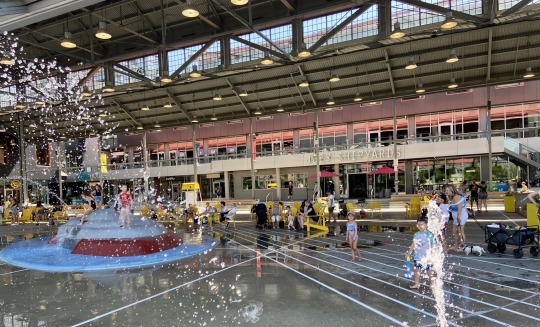
But, it’s not just about having more public spaces – it's about activating them. Imagine a public square with giant chess boards, live music, or pop-up markets. These kinds of events draw people in and create opportunities for spontaneous connection that might not happen otherwise.
You can build a great public space, but if there is no programming, people won’t come. North Vancouver’s Shipyards is a world-class example of how to design and activate a public space - with a massive waterpark (which transforms into a skating rink in the winter); gorgeous waterfront views; Adirondak chairs; giant toys and games; an ice cream shop; restaurants; breweries; a stage playing live music; regularly programmed events including movies, night markets, and yoga classes; art galleries; a public market; hotels; shops; public transit; and a seawall - all within 100 metres.
In comparison, when I visited Robson Square, Vancouver’s central public space, during the pandemic there was nothing going on except one tent trying to illegally sell marijuana baked goods. You can guess where most people would rather spend their time.
Third Spaces: More Than Just Coffee Shops

While discussing the benefits of walking and enjoying public spaces, Peg and I got on the topic of "third spaces." These are places that aren't homes or workplaces, but rather community hubs where we can gather, relax, and connect with others. Think of your local coffee shop, library, or even a dog park. These spaces are essential for fostering those spontaneous interactions with our neighbours that we may have lost during the pandemic.
Urban planning best practices suggest that every home should be within a 5-10 minute walk to a park, but we don’t talk about the importance of being able to easily walk to a coffee shop or corner store.
“I grew up in an apartment above a grocery store in Calgary. We had people buying groceries there, but also sitting on the deck or stairs eating popsicles and enjoying drinks. It became a gathering spot in my neighborhood, but I never thought about how important it was to have those places until the pandemic shut so many things down.”
Many cities are recognizing how zoning bylaws limit the ability to build these third spaces in residential areas. This includes Vancouver, which has streamlined the permitting process, offering micro-business licenses and creating flexible zoning regulations to allow for more mixed-use developments that include housing and ground-level shops or cafés.
Safe Streets and Small Interventions

When people can safely use streets for active transportation like walking and biking around their neighborhood, they are more likely to get out of their homes and cars to interact with their neighbors, support local businesses, and socialize outdoors. Sometimes, the simplest interventions to make our streets safe, like crosswalks, four-way stops, bollards, and lighting, can have the biggest impact.
Peg shared a story about her relatives visiting from Bogota, Colombia, who were amazed to be able to walk safely under Vancouver’s overpasses. It's a reminder that even details like well-lit walkways and wide sidewalks give people a sense of security and encourage walking.
We also spoke about how small, low-cost interventions such as adding more benches in our public spaces can build community. “One of my favorite episodes of the Alone Together podcast was about benches. They are special because they’re not just a place to sit, they’re spots available to anyone - that availability turns benches into opportunities for connections.”
“Benches are bridges between those eager to chat, and those wanting to just listen," said Peg. "When we sit on a bench, we’re indicating we’re part of a world that maybe we feel too lonely or afraid to fully participate in. Benches give us an opportunity to be engaged in our surroundings, whether it's observing from the side or opening up a chance for conversation.”
What Can We Do?
Rebuilding our connections in a post-pandemic city doesn't have to involve a lot of effort. Here are a few ways to start:
Support local businesses: Visit that new coffee shop, browse the farmers market, or check out a local art show. These activities help keep our communities vibrant and promote spaces for us to gather.
Get involved: Go to those local events in your community, or even volunteer to help organize one. Lobby your local government for safer streets and better public spaces. You might be surprised at how quickly you can connect with others who share your interests.
Start small: Organize a neighborhood gathering, strike up a conversation with someone on the bus, or simply offer a friendly smile to a passerby. Even if that means, you know, checking in on our neighbours, asking if someone is doing ok. These small acts of kindness can go a long way in building a sense of community.
We all have a role to play in creating the kind of city we want to live in. According to Peg, "we have a responsibility to reach out to other people to make our communities a place where everyone feels connected."
3 notes
·
View notes
Text
Urban Renewal: a new series on restoring community in a post-pandemic world
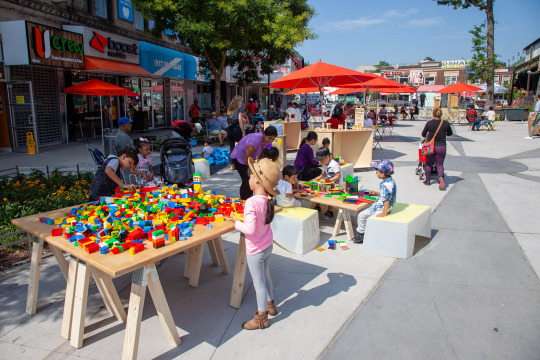
Over the past four years, I've felt increasingly disconnected. This is despite being more digitally connected than ever- to global events, my friend's lives on social media, and my workplace. I don't think it's just me feeling this way.
Since the pandemic forced people indoors and in front of screens, we've left behind the real world and our communities for a virtual reality. The local media landscape is shrinking, so we know little of what is happening around us and the virtual workplace means we spend more time at home and less time connecting with people face to face.
This has an impact on our cities, our communities, and our wellbeing. According to a recent a Meta-Gallup survey taken across 142 countries, nearly 1 in 4 adults across the world report feeling very or fairly lonely. The survey also found that the rates of loneliness were highest in young adults.
How do we restore a sense of community and authentic connection in a increasingly digital world - one where we are instead connected to misinformation, global politics, and algorithms 24/7 infiltrating our social media feeds with influencers, who persuade us to desire lifestyles that won't make us happy and buy things we don't need?
I believe the urbanist community has a role to play in helping solve these societal issues, so I'm launching a series to explore this topic from the perspective of local planning - how we design our cities and parks, activate our public spaces, restore nature in cities, fund community and arts programs, develop policies on safer streets and affordable housing, and more.
I'm calling the series Urban Renewal, a negative term in urban studies that refers to a 1970s North American policy of demolishing low-income communities to build massive freeway projects surrounded by desolate highrise buildings.
Renewal represents the process of revitalizing or rejuvenating something to its original state or improving it. I want to talk about what urban renewal should be, not removing vibrant communities in favour of cars and concrete, but actually restoring a sense of community that we seem to be losing to the virtual world.
I'm hoping to talk to a diverse range of perspectives for ideas on how to address this issue. Reach out to me if you work in urban issues and have thoughts about how to rebuild community in a post-pandemic world!
Photo credit: Street Lab (Uni Project)
2 notes
·
View notes
Text
Making space for children

One of my vivid childhood memories is of mundane trips that my mom and I would make to Vancity, the local bank. While she did her banking, I remember always playing with a Fischer Price phone at a kids table full of toys located near the tellers. Back in the 1980s, these kids tables were often found in doctor and dentist offices. But, I rarely see them now that I have kids of my own.
That's why I was impressed when I walked into the new vegan bakery hotspot in my neighbourhood, To Live For, and found that the owner, Erin Ireland, had put a large kids table right in the centre of the bakery's seating area. The little table has crayons, colouring sheets, toys, and a collection of books about acceptance and kindness toward animals and humans.
Even though the bakery consistently has a lineup of vegan influencers out the door, eager to try Erin's vegan treats and sit in the small seating area, she has taken a large piece of real estate and designated it for little customers! I've been there several times with my kids and the table is always full of children colouring, reading and stacking blocks.
I know a lot of businesses are actively looking for ways to discourage children from being in their establishment. Erin has proven that you can welcome children and still have a lineup of hip influencers out your door. If businesses want to welcome families, all they have to do is set up a small table, some toys, and art supplies. It's low cost and may even be good for their bottom line.
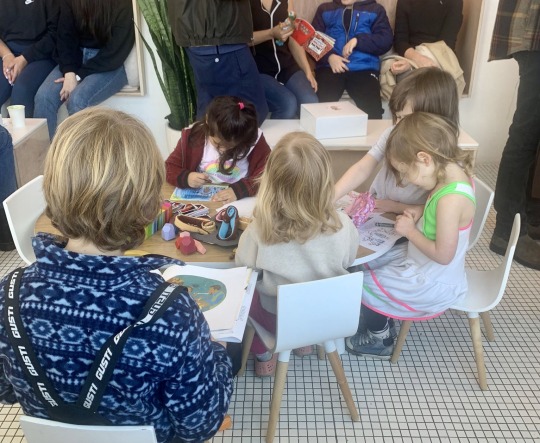
#kids in the city#family friendly cities#city success stories#city issues and ideas#vancouver#vegan#bakery#tolivefor
14 notes
·
View notes
Text
What could public spaces designed by girls look like?
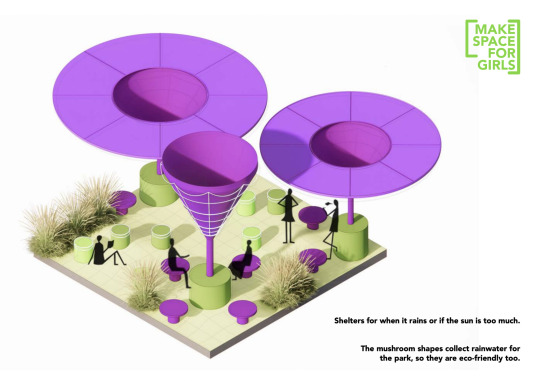
Last month, I wrote about how to design spaces for girls, based on research by Gerben Helleman, a Dutch urban geographer, who found that girls are restricted in their opportunities for play in many public spaces.
To continue this conversation, I discovered that Make Space for Girls, a non-profit organization that campaigns for girl-focused public spaces, released a set of design examples.
According to the organization, "the single best way to create a park which works for teenage girls is to talk to them. Find out how they use the park, how it makes them feel, and what would make it more attractive for them.
But it’s hard for girls to imagine what might work, because they’ve probably never seen a space designed for them. Which is where these pictures come in."
Of course, these examples could appeal and be enjoyed by anyone, but they are designed with the needs of girls in mind. Here are the examples:

The most popular request, swings, designed facing each other and away from little kids, so they are available to girls (who can talk and hang out while enjoying them).
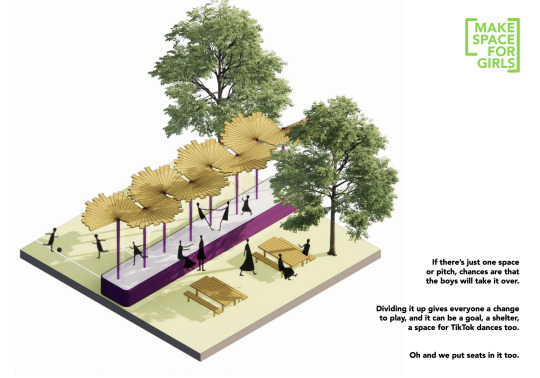
Divided spaces or pitches, so that boys don't dominate the space.
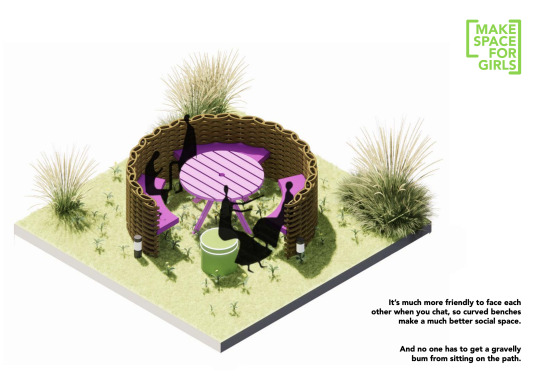

Curved, private seating areas or gym equipment where girls can face each other.
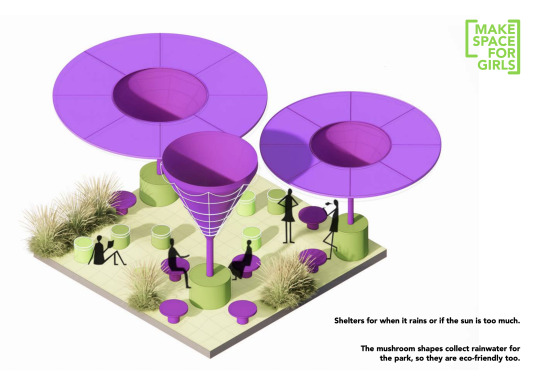
Seating areas with shelter from sun and rain.
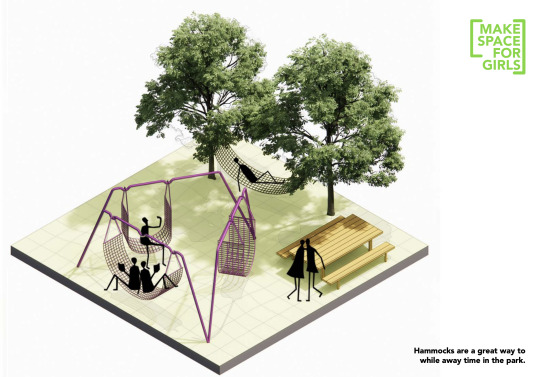
Hammocks for relaxation and quiet time.

Stages for performances and tree logs for seats and stepping stones.

High spaces for hanging out and climbing.
As a young girl, I would have loved to have any one of these spaces at a local park or gathering place to hang out with my friends. Cities and communities have spent too much time focusing on sports fields and playgrounds, and not enough time designing public spaces for youth to just hang out.
As you can see by the proposed designs, it's not even that complicated or expensive to create these public spaces. It just takes a willingness of communities to recognize that these spaces matter and are lacking, especially for girls.
Credit: all design images from Make Space for Girls.
#make space for girls#public space projects#urbanism#child friendly cities#family friendly cities#urban design#landscape architecture#public space
38 notes
·
View notes
Text
Vancouver approves future plan for growth
On July 22, 2022, Vancouver City Council approved the Vancouver Plan, a citywide land use strategy to create a more livable, affordable and sustainable city for everyone.
The Vancouver Plan is now the strategic framework for the city, proposing to add more housing options in complete and connected neighbourhoods, address the climate crisis, and support businesses of all sizes. You can learn more about it here:
youtube
4 notes
·
View notes
Text
Is this the most family friendly public space in North America?
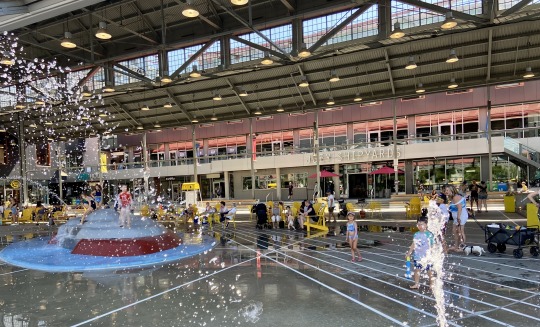
Imagine if there was a place you could take your kids with a massive waterpark (which transforms into a skating rink in the winter), a gorgeous view of the waterfront, shielded from the sun by a vaulted ceiling; surrounded by Adirondak chairs; giant toys and games; bathrooms; an ice cream shop; restaurants; breweries; a stage playing live music; regularly programmed events including movies, night markets, and yoga classes; art galleries; a public market; hotels; shops; public transit; and a seawall - all within 100 metres.
Are you in Europe?!?! No! You're at the Shipyards in the City of North Vancouver.
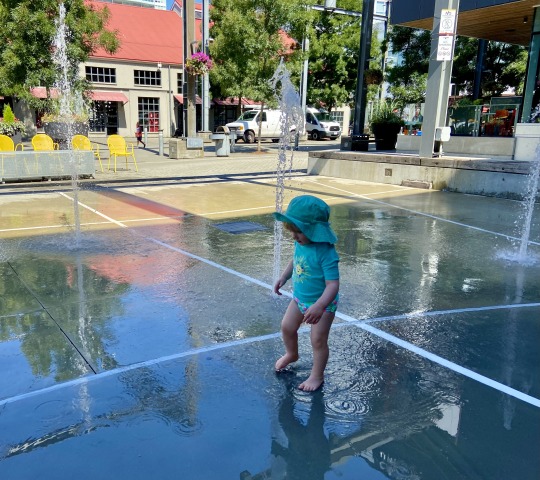
Yesterday on the hottest day of the summer, I was off work with my kids and ended up at the Shipyards (we go often since my parents live in North Vancouver). We were able to find a cool respite from the sun, splash our feet around in the water, and enjoy ice cream. You can't help but marvel at how it's perfectly designed to embrace children and families in public spaces.
Over the past decade, the City of North Vancouver transformed its waterfront lands into this unique, interactive, year-round public space that includes over 85,000 square feet of commercial and community amenity space.

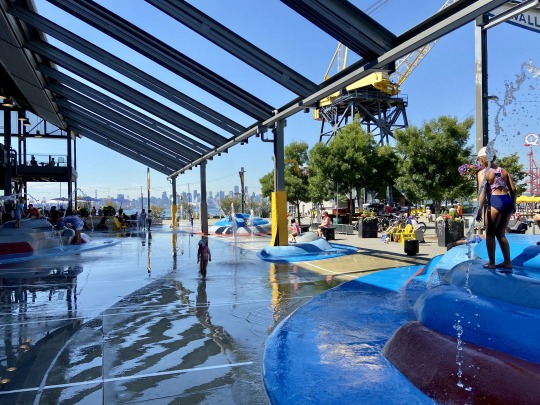
There's nothing like it in the City of Vancouver, even though there were plenty of opportunities to design a similar space with the Olympic Village, Coal Harbour, even downtown in the redesigned Robson Square. But, Vancouver proves time and time again that it cares little for young families and would prefer to keep things segregated and quiet. That way, we can all ride bikes, stare at the ocean, and not be distracted by play, activity, noise or anything suggesting fun.
youtube
Designed by local architectural firm DIALOG, The Shipyards was recently rewarded for its spectacular, people-centered design. In 2021, it received top honours in the ‘Excellence on the Waterfront Awards Program’ from the Waterfront Centre. The Centre was established in 1987 in the United States to recognize top-quality waterfront planning, design and development work from around the world.
According to the Mayor of North Vancouver, Linda Buchanan, "The Shipyards was designed to bring people together."
And it has been remarkably successful in doing so.
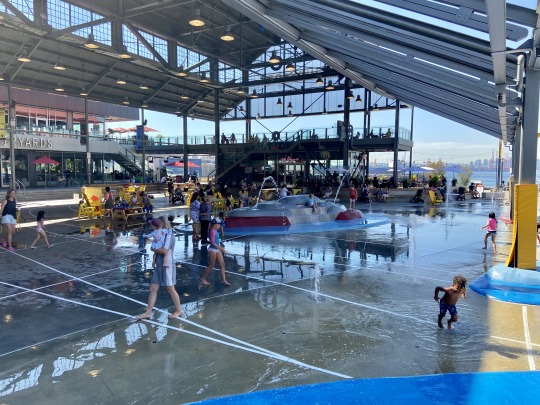
#public space projects#city success stories#family friendly cities#urbanism#shipyards#north vancouver#child friendly cities#playful cities#Youtube
0 notes
Text
I finally bought an e-bike
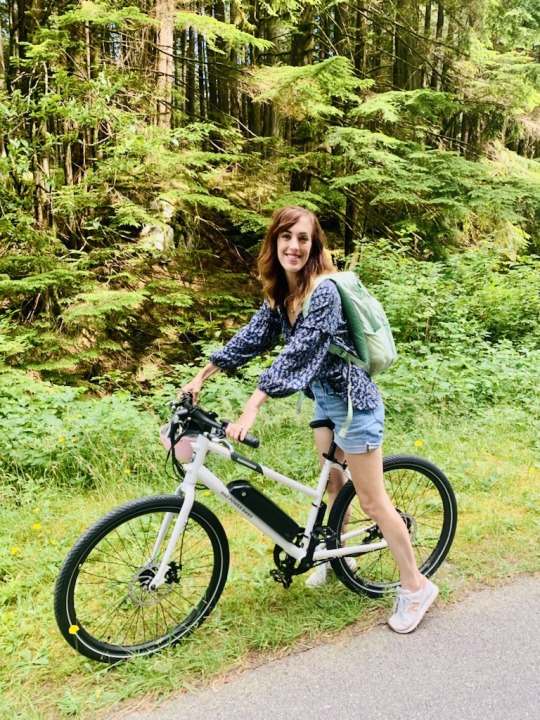
I've wanted an e-bike for the last few years, yet I always made various excuses to put off buying one: too expensive, could get stolen easily, how would I chose the right one, etc.
I finally went for it and bought one a few weeks ago, after visiting the Rad Power Bikes store in Vancouver. Rad Power Bikes makes some of the most affordable, highest rated e-bikes in North America; and they happen to be headquartered in Vancouver.
Their large showroom displays all the different bikes they carry and you can test ride any bike you want. I started with the Radmission Electric Metro Bike, their newest and lowest cost addition to the Rad bikes family. It is a single speed, lightweight e-bike, designed for easy transport.
As soon as I started pedalling, it felt like flying. The ride was smooth, effortless, and so much fun. It also gave me the same feeling of riding a regular bike, but with less effort.
I went on to try the RadExpand Electric Folding Bike (too awkward to sit in) and the RadCity Step Thru Commuter Bike, which was nice, but felt heavy and more like riding a moped scooter when compared with a regular bike. Neither of them came close to the joy I felt riding the Radmission.
My e-bike arrived last weekend and I took it for a ride with my family on North Vancouver's Seymour Valley Trailway. It was as smooth as my test ride; the only challenge was slowing down so that my husband (carrying our daughter) and my 8 year old son could keep up!
As someone who has had a few health issues that have made riding a bike challenging, I am so grateful for e-bikes. Having one will allow me to easily travel long distances by bike and up hills, which would've never been possible before.
2 notes
·
View notes
Text
How to design a place for teens and at-risk youth
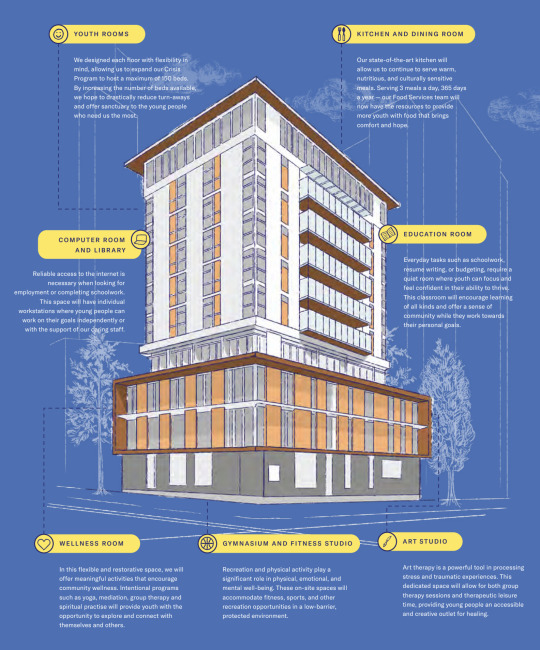
Covenant House recently opened a new 10-storey building to support at-risk youth in Vancouver. The building is a testament to how to design places for youth, with amenities and services including an art therapy room, classrooms, fitness facilities, and outdoor areas. That's because at-risk youth were involved closely in the design process.
Having worked as a mentor for Covenant House since 2018, I have seen the incredible work they do. I was recently invited to the grand opening of their new building and had a chance to ask them how youth were involved in the design.
How were youth engaged in designing the space?
Young people were at the heart of the design process, including offering ideas and thoughts in round table discussions and the chance to provide feedback directly to staff.
When we began this process we wanted to understand what worked for young people and didn’t and what would make our buildings feel safe, welcoming and homey.
Our new building is thoughtfully designed to meet the increasingly complex needs of youth. It has spaces that allow us to provide wrap around supports, leading to transformative healing and growth.
This expansion will not only allow Covenant House to welcome more youth, but to integrate feedback from youth, and think deeply about the ways these new spaces could support and enhance our programs.
In short, this building represents a commitment: youth shared what they want and need from our services, and we designed spaces that directly respond to that need.
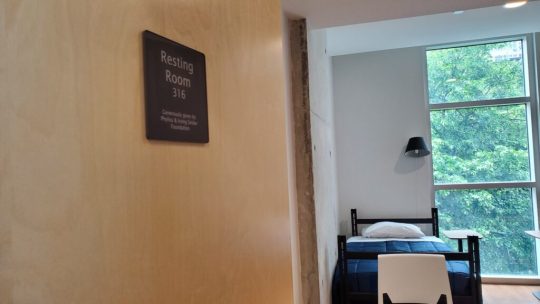
What were their priorities for the space and how was this reflected in the design?
When we embarked on this project over ten years ago, we knew that the number of youth experiencing homelessness was rising in Vancouver. We were turning away young people who needed our services, and knew we had to significantly increase our capacity to serve these youth.
One of our top priorities was to ensure that when young people asked for help we could say yes. Yes to a safe place to sleep, receive counselling or take a shower.
Some of the young peoples priorities were clean bright spaces with natural finishes, the ability to open windows and get fresh air, spaces where they could be outside without leaving Covenant House and ensure there was as many beds as possible while still providing privacy and in room washrooms.
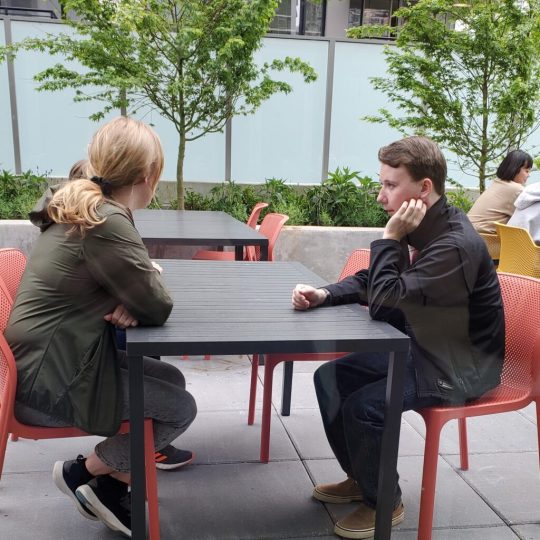
Some of the new, innovative services the increased space will make possible include:
An art studio and dedicated space for our incredibly successful Art Therapy program.
A classroom and computer lab, to encourage learning and provide youth with a sense of community while working towards their goals.
A meditation and movement studio, which will allow for more embodied therapy sessions and respite from stressors.
An incredible gym and the exercise room.
These facilities will give youth a safe and productive environment to work through challenging emotions and build healthy habits.

What are your hopes for the new space?
Our hope for our new space is above all else provide crucial supports to young people aged 16 to 24 who have fled physical, emotional and sexual abuse; those who have been forced from their homes; those who have experienced human trafficking and those who have aged out of foster care with no supports.
To have a real impact on the young people at Covenant House Vancouver, we must first show them that – unlike so many of the adults they have encountered in their life – they can trust us to guide them and support them with unconditional love and absolute respect.

The work we do with youth at Covenant House is holistic – it involves formal services like counselling, case management, and housing support, but it also involves the food we serve, the conversations we have, the space we operate in, and the informal activities we participate in together.
Each one of these elements is an opportunity to build a relationship – because relationship building is crucial and at the heart of what we do here.
Every time we sit down to share a meal with a young person, or work side-by-side with them to create a piece of art, or even lose – badly – to them at a video game, we build a little bit more of a relationship, and gain a little bit more of their trust. And trusting relationships are the foundation for real change.

#child friendly cities#urban design#urbanism#vancouver#city success stories#affordable housing#housing#covenant house#teenagers#youth#at risk youth#design
2 notes
·
View notes
Text
A taste of Vancouver history

A few months ago, I received a message from a reader named Robert Suess, who had discovered several old bottles of whiskey in an antique suitcase he purchased in Reno, Nevada. It turns out the bottles, which were almost 100 years old, were from United Distillers Limited, Vancouver's oldest distillery.
He wanted to know if I could connect him with a Vancouver historian who'd be interested in this rare find, so I put him in touch with Jason Vanderhill, who writes about Vancouver's history at his blog, Illustrated Vancouver.

Robert sent Jason some bottles, and the rest is history. A few weeks ago, I followed up with Jason, who recounted in detail how these bottles of whiskey were shared and enjoyed with local distillers and one of Canada's top whiskey experts:
It was a wonderful surprise to hear about a long lost stash of sealed United Distillers Limited (UDL) bottles. It matters not that these were 2 fl. oz. mini bottles - I have never ever seen an early UDL bottle that was still sealed! And I've been looking for over ten years since I wrote about UDL in a series of blog posts.
Robert was very kind to send me FOUR of these mini bottles, all still wrapped in their protective paper wrappings. Carefully unwrapping the bottles revealed that two of the bottles had completely evaporated, their corks having partly collapsed, but the other two bottles still had solid corks, and about half the liquid contents remained! The colour was a rich red/brown, and the whisky still appeared very clear and pure...like liquid gold!

These bottles appear to be very old, even though there's no date printed on them. This particular brand was one of UDL's 'flagship brands', which was advertised as early as 1929, and continued to at least 1940.
I decided to take one of the bottles to the Sons of Vancouver Distillery for a tasting back in May to share this rare bit of Vancouver whisky history with the next generation of distillers.
Things went without a hitch! The cork was carefully extracted, and the precious fluid ounce was shared among a half dozen 'official whisky history tasters'.
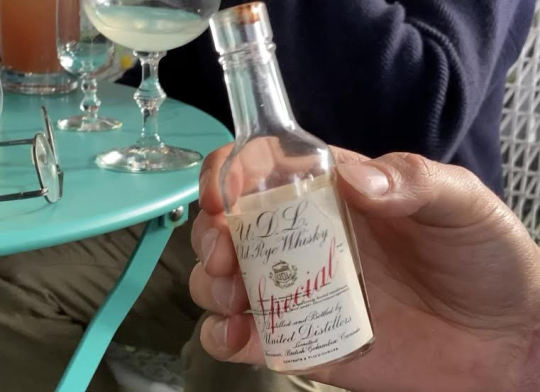
First impression upon uncorking the bottle - it still smelled very much like whisky. While there was some significant evaporation, we weren't sure if all the alcohol would have evaporated. Considering the bottles came from the hot climate of Reno, Nevada, it's more likely the water would have been prone to evaporate before the alcohol. So this drink was probably considerably stronger than the original spirit. And indeed, the whisky had great strength!
I could taste flavours from the old oak barrels, perhaps with a pleasant bit of menthol and other subtleties mixed in. The contents of the mini bottle were quickly consumed, and the memory of UDL was once again shared around the table.
But since I had been sent four of these bottles, two of which still had contents inside, I sent the other bottle to one of Canada's top whisky experts, Davin deKergommeaux. Davin has written the book on Canadian whisky...twice actually (author of Canadian Whisky and The Definitive Guide to Canadian Distilleries), and he's writing a third volume that delves even deeper into Canada's whisky history. Davin enthusiastically described it as 'a wonderful whisky', and he will be writing more about it in his forthcoming book.
It was a great personal thrill to finally witness the uncorking of an original UDL bottle. Yet more proof that our local whisky history is not entirely lost, and perhaps the best is yet to come.
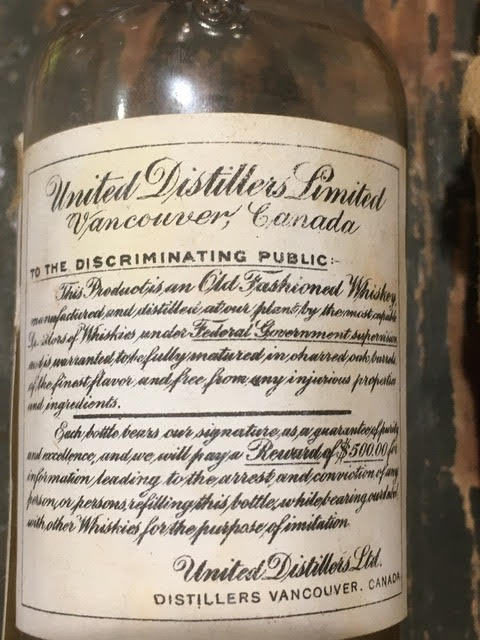
4 notes
·
View notes
Text
Here’s what happens when you take streets back from cars
I follow several urbanists on Twitter, so my feed is full of before/after pictures of city streets transformed by removing cars.
I know the mere suggestion of removing parking lanes, adding bike lanes, and closing streets to cars sends people’s blood boiling. This is why I always share these images. To show what’s possible when we allow ourselves to imagine a future without cars dominating our streets.
Here are some recent ones from my Twitter feed:
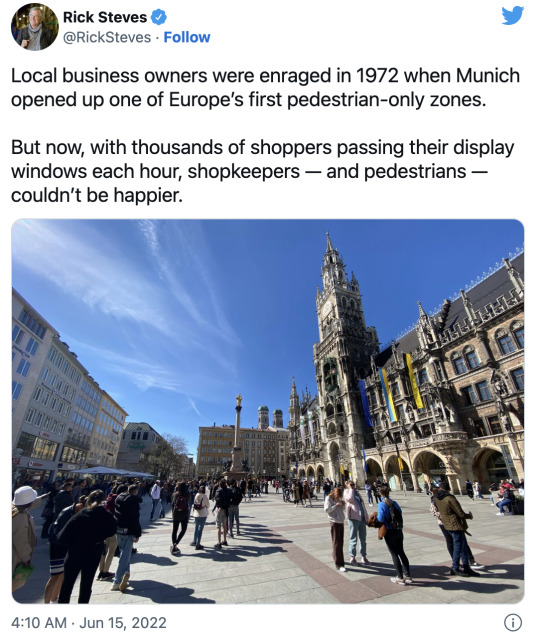



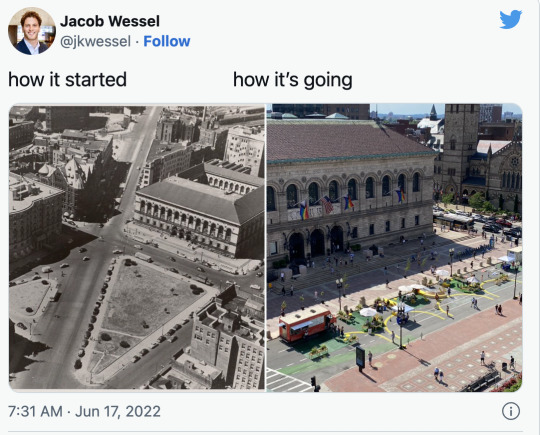
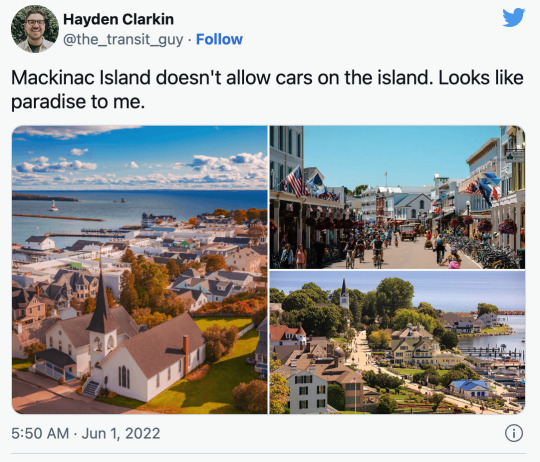

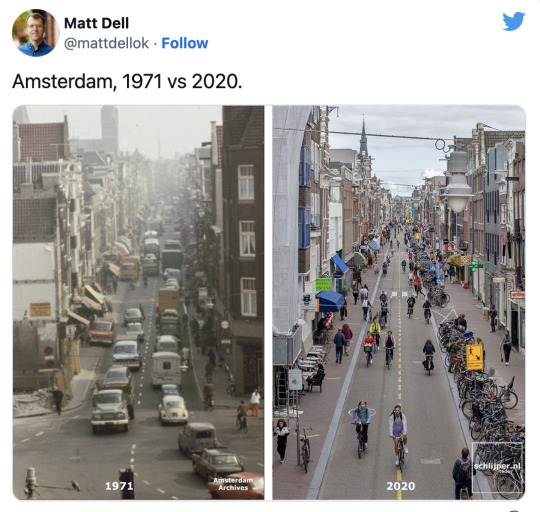

15 notes
·
View notes
Text
How to design public spaces for girls

When I watch my young daughter use the playground, I witness her confidence and sense of independence grow every time she climbs a ladder or goes down a slide by herself. These skills and emotions are crucial to her development.
While public spaces for children are theoretically designed to be genderless, Gerben Helleman, a Dutch urban geographer, discovered that in many play areas, different children - especially girls - are restricted in their opportunities for play.
Helleman’s research found that two-thirds of children playing outside are boys and only one-third are girls. And as girls get older, this ratio changes dramatically. Girls aged nine years or older are playing less in public space than their male peers, and girls are more 'supervised' than boys.
His article, Girls and outdoor play: looking for more equality and equity, looks at the reasons for this imbalance and how it can be prevented. Based on an extensive literature study, he comes up with some likely causes and possible solutions.

Figure 1. Who plays outside according to gender and age (Source: Playing outside: who, where and what?)
When it comes to why girls play outdoors less, Helleman found that public spaces are often designed to favour boy’s preferred activities. For example, his research found that boys and girls could be found equally playing in playgrounds and natural areas with bushes and shrubs, while the sports fields and lawns were dominated by boys.
The most important activity for girls was climbing, hanging or balancing. The second most important was 'doing nothing': relaxing, hanging out, sitting, watching or talking to other children. Boys were mainly engaged in ball sports.
“If you ask municipality officers what kind of places they provide for the older kids and youngsters, you’ll probably hear that they have several football pitches and skate parks. Due to a lack of user research, they won’t know these facilities are dominated by boys,” said Helleman.
“Research shows that girls only play at places where they feel welcome and in spaces not claimed by other groups, such as boys or older teenagers. Especially girls older than nine years, who don't feel comfortable at what they call ‘boys places’.”
I remember this acutely as a young girl. It’s the reason why I switched from co-ed to girls physical education class in Grade 9. In co-ed class, we had to play team sports where the boys dominated and wouldn’t pass the ball to girls. It was boring and demoralizing. When I joined girls PE, I got to learn self-defense and choreograph dance routines. I never forgot how to properly punch a guy in the face if he tried to attack me, which is much more confidence-building than being ignored during a soccer match.
So, where does this leave public spaces and how do we design them better for girls? According to Helleman there are several ways, including prioritizing safe walking and cycling access to parks, and public safety considerations like better lighting, good sightlines, paths with no dead-ends and locating facilities for teenage girls in well-frequented areas.

Helleman also makes some specific design recommendations on how to create public spaces for girls:
Allocate equal space for play equipment and sports fields - Make play areas big enough to facilitate play by both boys and girls. Terrain for play equipment (such as slides, bars, swings, climbing structures, sand boxes, water places) should take up as much territory as the area for ball games.
Think less in large, mono-functional play areas. Smaller places at one play space prevent girls from being marginalized, which can happen in big open spaces. Create more defined places in a play space with different play types and play activities for all generations and for people with different skills.
Create chill out areas. Besides playing, girls like to chill out. Create places and attributes where you can sit together face to face, hang out, socialize and chat are loved by many girls. That’s why a basket swing or hammock is chosen most often by girls as a place to play, sit, meet and chill.
Offer a bigger variety of play opportunities. Girls stay longer in play areas when there is a bigger variety of play opportunities. Therefore, provide a varied play area that is diverse in color, height, surface, materials, features, activities, and attributes. This offers possibilities for play as well as viewing, seating, and chatting options.
Include materials and places for creative play. Loose parts, including natural materials (sticks, branches, leaves, stones), moldable materials (sand, clay, chalk, water), and man-made objects without obvious play purpose (tyres, crates, ropes) provide opportunities to explore and engage in imaginative and constructive play, which girls like. Another way to stimulate imagination and creativity, is by making places for dancing, moving and (making) music.
Add natural elements (such as trees, bushes and water) that are accessible and playable. Nature often makes gender differences smaller. And perhaps even more than boys, girls are looking for adventure and places to experience, explore, investigate and use spaces for their own purposes (adaptability).
Connect to more gender-neutral forms of play, such as climbing and building. But also in terms of sports: so design a skate park with skate ramps and hills of different heights suitable for roller skates, stunt scooters, bicycles and skateboards, rather than a few very high half pipes that mainly attract male skateboarders.
And finally, make girls part of the planning and design process. “To incorporate the wishes and needs of children - and girls in particular - it is necessary that they have a serious role in the planning and design process,” said Helleman.
You can read Helleman’s full article here and check out his excellent blog, Urban Springtime, for more content on designing child-friendly cities. You can also watch the event that inspired it, ‘How do we make a city for an by girls,’ organized by Stadsform and Kind & Samenleving.
#Child Friendly#family friendly cities#cities#urbanism#Public Space Projects#girls#playground#Landscape Architecture#public spaces#design#women
31 notes
·
View notes
Text
Adding families to cities means adding density, in all its forms

As housing prices in cities sky rocket, the consensus across all levels of government and most Canadians is to speed up the process to build more homes. That consensus ends once we talk about what types of homes should be built to accommodate more families, especially in single-family neighbourhoods.
The truth is, many families that are priced out of the current housing market will never be able to afford a single family home unless prices drop off a cliff. These families don’t necessarily want a large home. But, they want housing stability or ownership of some form of housing so they can raise children without the constant threat of eviction and rising rents.
Families shut out of Vancouver’s Single “Family” Neighbourhoods
Meanwhile, many aging homeowners comfortable ensconced in single family neighbourhoods seem just fine with shutting young families out. This is on display at every city council meeting for a new housing development. Right now in Vancouver, we have evidence from Canada’s most recent census that the city lost almost 1800 children, who moved to other communities.
According to an article in the Tyee, an analysis by MountainMath found that the loss of children happened mainly in pockets of detached houses across the city. In contrast, densifying centres like UBC, downtown, Olympic Village and River District are gaining them.
“We’ve legislated [those neighbourhoods] into decline,” said MountainMath founder, Jens von Bergmann in the Tyee interview. “We have laneways and we do duplexes, but it’s a slow trickle to stem the tide.”
To summarize, he put it simply:
“If you don’t add housing, you lose kids.”

136,000 homes needed in the next 10 years
The City of Vancouver’s first-ever Housing Needs report found that over the next 10 years, it is estimated that 136,000 households will need housing suitable for their family size and income. This includes the unmet needs of existing residents in about 86,000 households, including:
- 77,000 households living in unaffordable, unsuitable, or inadequate housing,
- 2,000 people who are homeless, and
- 7,000 people living in SRO situations.
Meanwhile, the City of Vancouver is proposing a large increase in density - up to 5,000 homes around the new Broadway Skytrain line stations - and current residents are out in front of city hall with picket signs complaining the towers are too high.
There is no doubt that many of Vancouver’s single family neighbourhoods are lovely, peaceful communities full of tree lined streets and beautiful gardens. But, they are literally dying because no young family can afford to live in them anymore.
As an example, my Dad’s former colleague sold his home in Dunbar for over $3 million and moved to North Vancouver (still a destination of choice for families but also becoming unaffordable). He said he was the last person actually living in his neighbourhood and most nearby homes sat empty after being purchased by foreign investors.

Is “gentle density” enough at this point?
The Broadway Plan is a radical departure from current Vancouver planning policies because it proposes high rises near the city’s beloved single family neighbourhoods on the west side. These are areas where housing is out of reach unless you have two robust six figure incomes, a healthy savings, or wealthy benefactors.
For years, Vancouverites have touted the idea of building more “missing middle” or “gentle density” housing forms to increase housing supply in Vancouver’s single-family neighbourhoods. This includes laneway housing, duplexes, townhomes, and mid-low rise apartment buildings.
The problem is, these housing types (with the exception of duplexes and laneway homes) aren’t being built fast enough or are only being built on busy arterials. The privileged, single-family home owners of Vancouver won’t allow them anywhere else.
In a CBC interview from 2017, Vancouver architect, Michael Gellar, said that if Vancouver wants to introduce more density into the city, it can be done without transforming the city into an endless row of high-rise towers. According to Michael, even though low to mid-rise buildings won't achieve the very high densities of high towers in a concentrated area, overall across the city they could achieve much higher densities.
This idea of gentle density across Vancouver is now being promoted by those against the Broadway Plan. The problem is, that because of Vancouver’s long history of bowing to opposition to density in single-family neighbourhoods, it may be too little too late for this proposal.
It took the city four years to create the Vancouver Plan, which is basically a position statement on allowing gentle density in single family neighbourhoods. But, it has no concrete plan on how to deliver this housing. Also, I would argue that we are so far behind on building gentle density, that given our track record of slow permitting processes and NIMBYism, we may never build enough homes fast enough to address Vancouver’s affordability crisis.

Creative solutions to density face challenges
Last month, Bryn Davidson, founder of Lanefab Homes, shared on Twitter his designs for the “Fab Plex,” a 6 unit development that could be built on a typical Vancouver single-family lot (pictured above).
“The ‘Fab Plex’ are six stacked flats with big balconies, a shared roof deck, and a large green space at the back,” said Bryn. “The units are all accessible, and there is very little excavation/concrete required. Also, the basic footprint can work for 3 to 8 storeys, so it's a built form that can evolve as the city densifies.”
Whether or not local residents would support this type of density in their neighbourhood remains to be seen, and city planners told Bryn that providing sewage capacity for this type of development is complex.
“Big projects can pay to upgrade the sewers for the whole block, but a six plex can't afford that, so the sewer constraints start to limit what is possible with incremental density,” said Bryn. “My hope is that we can get around the sewer constraints by maintaining a very water permeable site with no underground parkade.“
When I asked him about next steps, he said that they would have to see if the “positive tradeoffs” (accessibility, green space, unit size, energy efficiency) are enough to offset “the inevitable anxieties about something that looks like a little apartment building, and has blank party walls on the property line where it would be adjacent to existing single family houses.”
"You can't help but be inspired," he says. "You are going to see more of these buildings being built because they're going to be built in locations where you can't get approval to build high-rises given current community attitudes."

Vancouver at a crossroads
I have profiled many families who chose to live in cities and written article after article on how to build a family friendly city and how Vancouver falls behind in this arena. The city continues to attract young and retired people, while families leave in droves.
I’ve watched many friends move here in their 20s and leave as soon as they got married and had children. I don’t blame them. Finding stable housing, affordable licensed childcare, and schools can be near impossible.
There are many creative design solutions to add homes to single family neighbourhoods. But, none of these solutions are possible until we change our attitudes about preserving single-family neighbourhoods (where families no longer actually live) and build more homes, whatever the form.
Photo credits: TrafficTrish (title image); Jen Van Bergman (graph); Francis Georgian/PNG (protestors at Vancouver City Hall), Lanefab Homes (Fab Plex design)
#family friendly cities#Child Friendly#Vancouver#urbanism#broadway plan#city issues and ideas#density#affordable housing
3 notes
·
View notes
Text
Vancouverites agree city needs more housing, yet it’s not happening fast enough
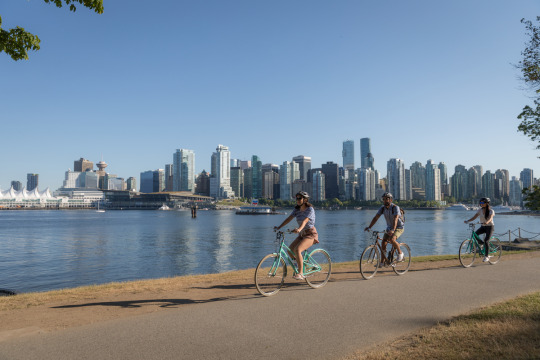
Images of Vancouver often showcase residential towers surrounded by snow-capped mountains, beaches, and seawalls packed with cyclists and pedestrians. The city comes across as dense and packed with people living close together. This is not the reality.
The truth is that once you leave the downtown core, Vancouver is a sleepy suburb with 81% of its residential land devoted to single-family homes, and prices that are completely out of reach for most families. I recently moved to one of these neighbourhoods, into a new duplex in a sea of single-family homes on massive lots.
I used to live in a smaller duplex that was two blocks away from a vibrant street called Commercial Drive, surrounded by a mix of housing types. I love my new home, but being in a single family neighbourhood means bigger homes, spaced far apart. Some streets have no sidewalks and I have to cross busy arterials to get to the local park and coffee shop, which is now 8 blocks away.
I miss the walkability, energy, and friendliness of living in a more dense neighbourhood. I desperately want more people in my new neighbourhood - more duplexes, triplexes, townhomes, even low-rise apartments, including rental and co-op housing. With more people, there would hopefully come more amenities like shops and recreation - even just basics like more crosswalks and sidewalks!

Vancouver’s landscape of predominantly single-family homes
Apparently I am not the only one. 78% of people surveyed for Phase 3 of Vancouver’s citywide plan agree that Vancouver should have a range of housing options in all neighbourhoods, particularly in areas with low density. These are majorities over 70% that want all forms of dense housing in the city’s predominantly single-family neighbourhoods:
- Over 80% supported low-rise apartments up to six stories, multiplexes and townhouses in areas that are mostly single detached homes; 48% said mid-rise up to 12 stories are acceptable.
- 77% supported rental housing options on smaller, local roads within neighbourhoods.
- 68% agreed all neighbourhoods should have housing options through increased heights and density for those who make less than $80,000 a year.
- A majority of respondents indicated a preference for density to be spread out with more 6-12 storey buildings distributed throughout rapid transit areas, versus concentrations of over 12 storeys closer to stations.
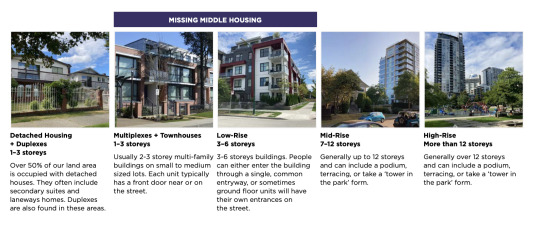
Housing types according to the City of Vancouver
Unfortunately, none of these homes are being built fast enough. The process to develop housing in Vancouver and neighbouring municipalities is so slow, it’s become a provincial and federal issue. A report jointly commissioned by the federal and provincial governments in August 2021 identified municipal government policies as a major barrier for improving housing affordability and supply in Metro Vancouver.
The study’s authors recommend the provincial government enact statutory time limits to every stage of the property development process. According to Urbanized journalist, Kenneth Chan, the report also suggests more transparency on city staff’s pre-application process, which was a step taken by Vancouver City Council this past spring after it discovered city staff had put in limbo 70 pre-application rental housing proposals since 2020.
Amidst growing criticism that slow permitting processes are partially to blame for the housing crisis, the City of Vancouver says it’s made progress in clearing its massive backlog. According to a recent City of Vancouver release, review time per application for single-family, duplex, and laneway homes have been reduced by 75%, leading to a 300% increase in applications processed.
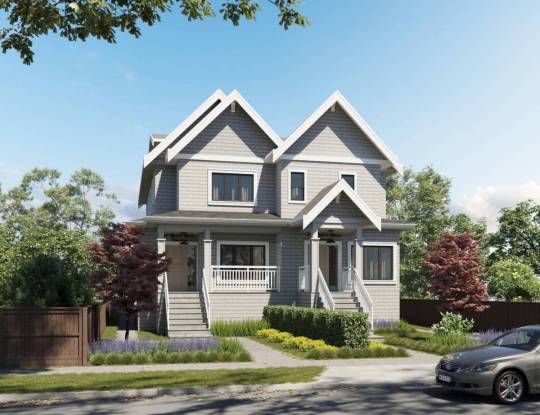
Duplexes on Vancouver’s westside, sold for almost $3 million each.
This will not lead to a significant improvement in affordability in Vancouver’s housing market, since it only applies to duplexes, single-family, and laneway homes. What is really needed is not just new homes replacing old ones, but more homes in varying densities.
During the pandemic, people left Vancouver in droves. According to the recent census, Vancouver’s population declined for the first time in 40 years. After decades of steady growth, data from Statistics Canada shows Vancouver population in 2020 at 700,015 but in 2021, it dropped to 693,235, a difference of 6,780.
I personally know at least 5 families that left for smaller, more affordable communities during the pandemic. Many were renting in the city and were able to purchase a home elsewhere. They wanted to stay, but could not afford to. Families who were renting were constantly being evicted every 1-2 years from owners who wanted to sell. This is not sustainable if you have children in a school-catchment.
These were hardworking families with good jobs that could have been stayed valued members of our city. But they were not valued, because Vancouver couldn’t offer a stable home for them. We can’t afford to lose more families. So let’s get on with it and build more homes.
Cover Photo: Destination Vancouver/Rishad Daroowala
8 notes
·
View notes
Text
Cities for women and girls

I am excited to be participating as a moderator at the Urban Economic Forum’s virtual event, "North America, Women, and Urban Sustainable Development Goals: A Shift Towards Gender Equality," on March 7th and 8th. The event will involve discussions on how to empower women to play a greater role in urban planning and design, while also addressing the needs of women and girls in cities.
Urban planning, engineering, and design have traditionally been male-dominated fields. This is reflected in how often cities don’t adequately meet the needs of women and children. For example, affordable housing that doesn’t include three bedroom units, neighbourhoods unsafe for women to walk at night, streets with no sidewalks or sufficient crosswalks for women to comfortably walk with their children.
According to the Women Friendly Cities United Nations Joint Programme, woman friendly cities are cities where women can access:
- health, education and social services. - employment opportunities. - high quality, comprehensive urban services (such as transportation, accommodation and security). - mechanisms that guarantee their rights if they are subjected to violence.
They are cities where local governments take into account women’s issues and perspectives in their planning and decision-making processes. And, women are supported and encouraged to participate in all areas of urban life on an equal basis with men.
I look forward to moderating some engaging conversations on these issues in a few weeks!
3 notes
·
View notes
Text
Changing how we talk about cars hitting pedestrians and cyclists

Excerpt from a CTV news article published on Jan 21, 2022:
Several pedestrians are in hospital with life-threatening injuries as a result of three collisions in Metro Vancouver.
The first happened in West Vancouver.
An elderly woman was struck by a truck as she crossed 13th Street at a marked crosswalk before 1:30 p.m. Wednesday.
"The driver remained on scene and is co-operating with police," Mounties said in their statement.
At the time, drivers were warned traffic would be disrupted for several hours and were asked to avoid the area.
This news article is a text book example of the formula that media use when reporting on collisions involving drivers hitting pedestrians or cyclists. It goes like this:
1.) Always frame the collision* in the passive voice, putting the focus on the pedestrian being hit by a vehicle (never on the driver who hit them).
2.) Barely mention the driver who caused the collision, except to say whether they remained on the scene. If they did, use positive language about how they are "cooperating" with police.
3.) Finally, even if someone has died or suffered life threatening injuries, state if the collision is causing traffic delays and inconvenience to other drivers.
When we constantly read these news reports, we are led to believe that car crashes involving pedestrians and cyclists are an unavoidable fact of life in our cities and communities. This is wrong. These tragedies can be prevented, we just aren't doing enough to examine how.
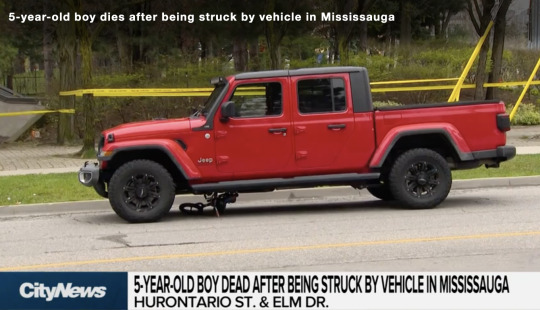
In her new book, There are No Accidents, journalist Jessie Singer argues that this predisposition to blame human error and accept the old adage that "accidents happen" is not only misguided, but insidious. It covers up the systems that enable accidents.
Singer's book includes a tragic personal account of how in 2006, her best friend, Eric, was hit by a drunk driver while riding on a bike path in New York City. The driver was convicted of DUI and vehicular manslaughter. Nine years later, another drunk driver killed a cyclist on that path. Two years after that, in 2017, a truck driver deliberately plowed into the spot where Eric died, murdering 8 people and injuring 12.
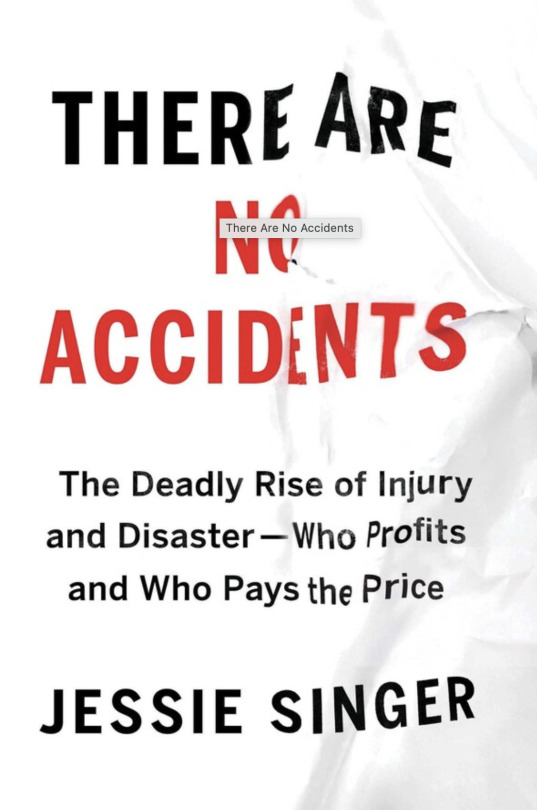
According to a review in Washington Monthly, after Eric’s death, Singer was livid that some accident inspectors focused on his not wearing a helmet. But she pointed out that Eric was hit by a car going 50 miles (80km) per hour. As a result, donning a helmet would not have mattered. Multiple deaths on that same path proves the weakness is in the design.
Pedestrian and cyclist fatalities are at an all-time high. They are also the leading cause of death for children in Canada. Most are preventable, and yet these media reports never examine how to hold governments accountable for measures like lowering speed limits, increasing pedestrian cross walks, deterring traffic through residential neighbourhoods, adding bollards and separated bike lanes, and reducing lane size so that neighbourhood roads look less like highways.
We place the onus on the victim to not get murdered by 3,500 lbs of steel. How often do police and local car insurance companies proudly launch pedestrian safety campaigns where they hand out reflective vests and flashlights and warn pedestrians to "make eye contact" with drivers. Tell that to a 5 year old, or to this crossing guard who got hit saving a child's life while a car barrelled through a cross walk without stopping.

This is what hero police officers do! North East Police Officer Annette Goodyear saved a student from harm’s way early this morning. pic.twitter.com/efpgjqucuO
Even this story focuses on the victim. Who was the driver? We rarely hear whether the driver was speeding, distracted, or even drunk. In most of these cases, it is highly likely that one or all of these is true, because your likelihood of seriously injuring a pedestrian or cyclist is pretty slim if you are obeying the rules of the road. And if that is not the case, there is something wrong with those rules and they need to be changed.
Either way, a person shouldn't die while out for a walk or a bike ride and have this accepted as an unpreventable accident. We need more cities and communities to get serious and invest heavily in Vision Zero policies and infrastructure. I fully agree with Singer’s hypothesis that every accident is preventable. And changing the narrative starts with how we frame car crashes in the media.
*Note - In this post, I initially referred to car crashes as “car accidents” and a thoughtful reader pointed out that they should be called “collisions” or “crashes.” Even I was predisposed to call them accidents. According to the US Department of Transportation:
“Changing the way we think about events and the words we use to describe them affects the way we behave. Motor vehicle crashes occur "when a link or several links in the chain" are broken. Continued use of the word "accident" implies that these events are outside human influence or control. In reality, they are predictable results of specific actions.“
Photo credits: Joe Flood; City TV news clip.
#urbanism#car accident#walkable communities#media#journalism#city issues and ideas#pedestrian fatalities#pedestrian safety#cyclist#safety#accident#road safety
52 notes
·
View notes
Text
Back at it
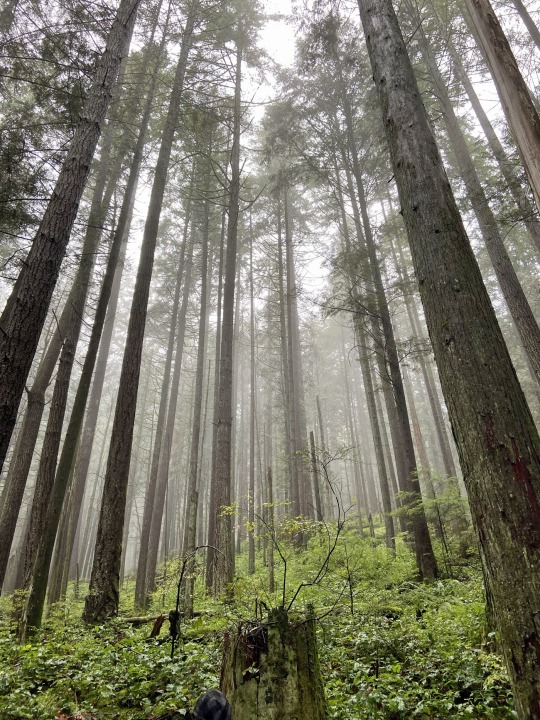
As we approach two years of pandemic restrictions (or 200 depending on how you feel), I have been quietly watching our cities and communities in decline. Everything that makes cities great places to live involves connections with the people around us. And COVID has taken that away.
On the plus side, people are spending more time in nature and advocating for more green spaces in cities. But quarantines have meant that our public spaces are not activated, our live music and arts venues remain closed, public transit use has declined, and with less people on the streets, incidents of violent crime, property damage, and theft are rising.
While this has been happening, I have not been writing. These last two years involved me welcoming my second child and between pregnancy and maternity leave during a pandemic, I have not felt motivated to write.
But, there is so much I want to write about - how to bring life back to our downtown core, how to make safer streets, the importance of public schools, addressing climate change, bringing Indigenous perspectives into city planning and parks - to name a few.
That is why, I am back at it. Relaunching This City Life (now www.thiscitylife.ca) to start these conversations on how to continue to make cities and communities great places to live in a post-pandemic world.
I will be posting 2-4 times a month and look forward to reconnecting with city lovers and city makers around the world.
0 notes
Text
From Railway to Greenway: How Vancouver is transforming a rail line into a destination park

My contribution to Park People’s 10 Years Together in City Parks.
As a child growing up on the westside of Vancouver, the railroad track along the Arbutus Corridor ran behind the tall hedges of our backyard. My sister and I would play along the tracks with neighbourhood kids, often leaving pennies behind to discover them flattened by passing trains the next day.
Children have a way of turning any space, even an industrial rail line, into a place for social gathering and play. Almost 40 years later, many cities around the world have adopted out-of-the-box thinking, converting underused industrial land into public spaces. This innovative approach to park design includes the Arbutus Corridor, which the City of Vancouver purchased in 2016 and is working to transform into the Arbutus Greenway, a ribbon of pathways and parks through the heart of Vancouver’s westside.
“The Arbutus Corridor has a history and it runs through parts of the city that in everyone’s minds are already developed,” says Antonio Gómez-Palacio, a partner at DIALOG, the urban planning firm that led the design and engagement process for the project. “Converting it to a greenway was an act of tenacity and creativity, working with the community to see the world in a different way, and to see a park there waiting to be discovered.”
The Greenway’s history spans over 100 years – from its beginnings as a railway for passengers and local industry, to contentious negotiations between the City of Vancouver and CP rail for its purchase. Today, it is an active transportation pathway that runs from the tourist destination of Granville Island to Vancouver’s southern edge, overlooking the Fraser River. In the future, it will become a multimodal corridor linking a series of destination parks and public spaces, and in the meantime, the local community has found creative ways to bring people together along its path.
Read on at Park People.
#Public Space Projects#Arbutus#Greenway#urbanism#public space#urban design#Landscape Architecture#Vancouver
0 notes